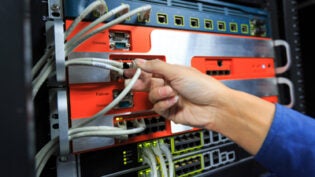Point-to-Point Cabling vs. Structured Cabling: Choosing the Right System for Your Business
By: Scott Resnick

While choosing a data cabling system for your business, you’ll encounter two options: point-to-point cabling or structured cabling. Because cabling plays an integral part in any IT environment, it’s important to select the right system, so your data needs are met in a sustainable and reliable way. Keep reading to discover which cabling system is best for your thriving company. We’ll walk you through the pros and cons of both types of systems.
Basics of Point-to-Point Cabling
Point-to-point cabling is the older method of creating a data system. This system works by using jumper fiber cables, which connect a switch, server, or storage unit to another such device. Because point-to-point requires a new cable for each individual connection, it’s sufficient for a small data system setup.
However, if your business has numerous switches, servers, and storage units, you are advised to steer clear of point-to-point cabling systems. The reason behind this advice becomes clear when you walk into a room that’s filled with point-to-point cables. Simply put, it’s a giant, sprawling mess.
While the initial cost of point-to-point cabling is lower than structured cabling, chances are you’ll end up paying more over time. Point-to-point systems can be a nuisance for a quickly expanding company. Over time, it becomes more difficult to continue adding the individual fiber cables. It’s also a challenge to keep track of which points are actually connected underneath your spiderweb of cables.
Benefits of Structured Cabling
Unless your business is small and you don’t anticipate future growth, save yourself the heartache of point-to-point cabling and install a structured cabling system instead. Created in direct response to point-to-point cabling’s limitations, structured cabling provides a hierarchical infrastructure, making it much simpler to connect a large number of units to a single server, for instance. This ability is achieved through distribution areas that provide more versatile connection points, rather than filling the room with cables.
Structured cabling provides a myriad of benefits. Beyond the system’s superior flexibility, structured cabling offers a long-lasting technology, which is built to evolve alongside the company. Even if you undergo a sudden surge of growth, a structured system can keep pace with your needs. Finally, while a structured system is a greater upfront investment than a point-to-point one, it pays for itself over time through lowered IT costs and increased employee productivity.












